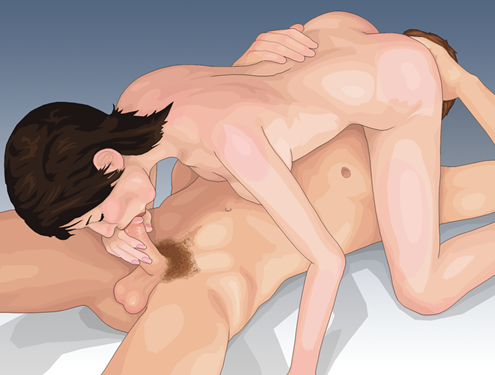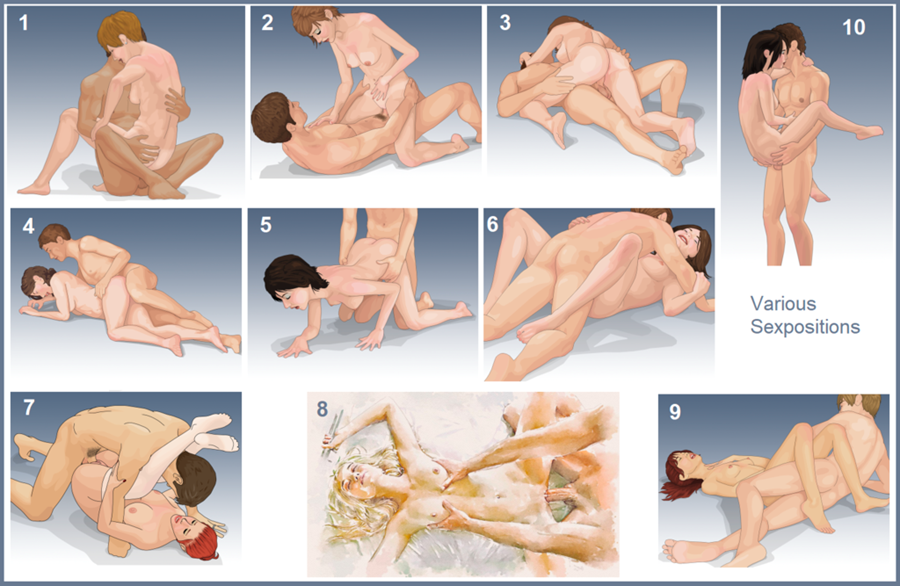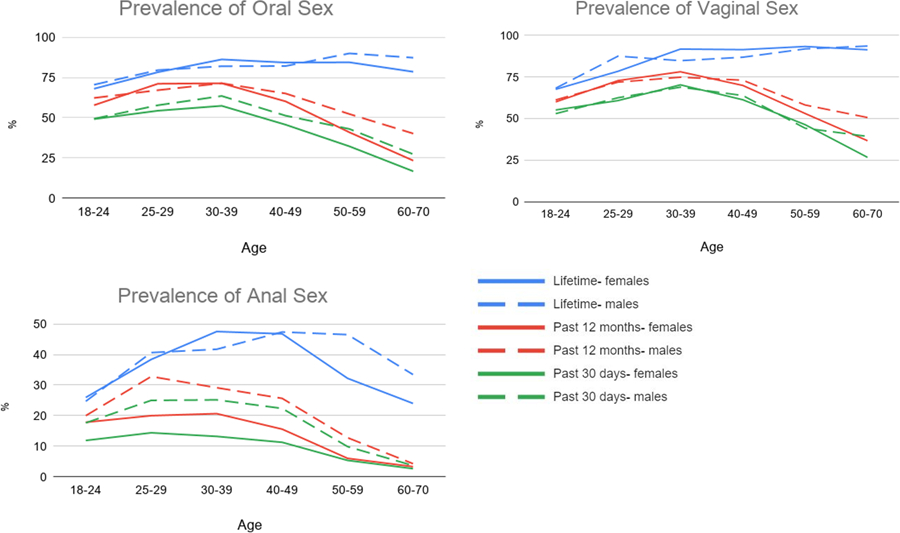9.5: Sexual Behavior
- Page ID
- 167889

Autoeroticism
As we first discussed in Chapter 4, Masturbation, also known as auto eroticism, is often when a person touches, strokes or rubs their own genitals for sexual pleasure, but orgasm can also be achieved without touch by merely fantasizing, is one of the principal forms of one-person sexual expression. Other forms of individual sexual experience, such as sexual fantasy, may or may not be accompanied by genital stimulation. Masturbation techniques vary widely depending upon a person's body and preferences. For example, masturbation may be practiced by manual stimulation of the genitals, sometimes with the aid of artificial stimulation with a sex toy (see Chapter 4 for more on sex toys!). Before a person conceives of sexual experience with other people, they learn early in childhood that touching their genitals can produce pleasure. However, according to the findings of the 1992 National Health and Social Life Survey (NHSLS), there are other reasons that people masturbate (Laumann et al, 1992). The other reasons may include to relax, to relieve sexual tension, when partners are unavailable, when a partner does not want to engage in sexual activity, boredom, to help get to sleep, and fear to engage in sexual activity due to fear of HIV/AIDS and other STIs. Across individual of all sexes, masturbation habits vary in type of motion applied, speed, pressure applied and whether a person incorporates sexual imagery and sexual fantasies.
Masterbation Techniques
Most people with penises report that they masturbate by manual manipulation of their penis. Usually, they shift from a gentler rubbing action during the flaccid or semi-erect state of arousal to a more vigorous milking motion once full erection takes place. They are likely to stroke the glans and frenulum at the outset, but their grip tightens and the motions speed up as orgasm nears. At orgasm, the glans become sensitive and contact with it is usually avoided, but the penile shaft may be gripped tightly. Instead of using soap suds as a lubricant for masturbation during bath or showers, which may irritate the skin, it is more effective to use other lubricants, such as petroleum jelly, K-Y or other commercially available lubricants that are more effective at helping to reduce friction and simulate the moist conditions of coitus.
Vaginal/clitoral stimulation techniques also vary widely, but some general trends exist. Most people with vulvas masturbate by massaging the mons, labia minora and clitoral region with circular back-and-forth motions. Some straddle the clitoris with their fingers, stroking the shaft rather than the glans. Because of its exquisite sensitivity, the glans may be touched lightly only during early arousal. Clitoral stimulation is achieved by rubbing or stroking the clitoral shaft of pulling on the vaginal lips. In contrast to the myth that people with vulvas usually masturbate by simulating penile thrusting through the insertion of fingers or penis like objects into their vaginas, relatively few do, and most achieve orgasm through clitoral stimulation only. Still, some report erotic pleasure from deep vaginal penetration, but most precede or combine it with clitoral stimulation. Many people with vulvas masturbate by spraying their genitals with jets of water. During masturbation, some also massage other erogenous areas of the body, such as their breasts or nipples with the free hand.
Fun fact. Female Hysteria was a popular diagnosis in the Victorian days and doctors (who were all male) treated it by clitoral stimulation to achieve orgasm. At first they used their hands, but decided to invent a machine to do the work because their hands were getting tired, thus bringing about the birth of the vibrator. For more on this, watch: Hysteria - Trailer.
Historical Views of Masturbation
Historians suspect that people in ancient times condemned sex that did not lead to pregnancy because of the need for an increase in population. This need for progeny is also linked to the view that penis-in-vagina (PIV) intercourse within the context of a heterosexual marriage was the only morally acceptable avenue of sexual expression. Masturbation provides pleasure, but not procreation, so the attitudes of many world religions toward masturbation reflected the censure that was applied toward nonprocreative sex. Despite this history, there is no scientific evidence that masturbation is harmful, but rather, quite healthy. It does not cause psychological or physical harm, except for rare injuries to the genitals due to rough stimulation. Sex therapists have used masturbation as a treatment for individuals with low sexual desire and for those who have difficulty reaching orgasm. People who consider masturbation wrong or sinful may experience anxiety or guilt about it, but these negative reactions are due to their beliefs about masturbation, not the behavior itself.
Sex with others
There is a great variety of partnered sexual behaviors, far too many to list here. We will discuss some better known activities and invite you to further research the wide world of sexual expression and maybe come up with something completely new. Some activities we will describe as “partnered,” which can include two or more people. We will discuss behavior for people with the same genitalia and different genitalia. We will also address some of the misconceptions about same-sex sex lives.
The age of a first partnered sexual encounter varies based on the specific activities and cultural background. A study by Regan and colleagues, “Gender, ethnicity, and the developmental timing of first sexual and romantic experiences”, investigated the age at which an ethnically diverse sample of young adults (N = 683) experienced their very first date, love, serious relationship, kiss, and act of intercourse (Regan et al, 2004). Most had experienced each event by the end of high school, with first dates and kisses occurring at earlier ages than falling in love or intercourse. Gender and ethnic differences were found. For example, young men began dating at earlier ages than did young women. Asian American participants were less sexually and romantically experienced, and had their very first sexual experiences at an older age, than African American, Latino/Hispanic, and Caucasian/non-Hispanic White participants. Interestingly, there were no differences in first romantic love experiences. Almost all men and women within each ethnic group had fallen in love at least once, typically around age 17; this suggests that romantic love is a common human life event, and that it first occurs during the developmental period spanning late adolescence and early adulthood. The below summarizes the findings of this research.
Age in years at which participants experienced romantuc/sexual "first" by ethnicity:
| Latino(a)/Hispanic | White/Caucasian | African American | Asian American | |
|---|---|---|---|---|
| Kiss | 15.20 | 14.52 | 14.83 | 17.60 |
| Date | 15.75 | 14.53 | 17.53 | 16.12 |
| Sexual Intercourse | 17.33 | 16.97 | 16.31 | 18.85 |
| In Love | 17.48 | 17.62 | 17.25 | 17.40 |
| Serious Relationship | 17.91 | 17.56 | 18.00 | 19.05 |
Table 1. Adopted from Regan, Durvasula, Howell, Ureno, & Rea, 2004, “Gender, ethnicity, and the developmental timing of first sexual and romantic experiences”
After the first sexual debut, partnered sexual behavior often continues through the rest of people’s lives. Good health, having a positive view of one’s own sexuality and having a partner are all factors related to continued partnered sexual activity into people’s 60s, 70s and even into their 80s. Sex continues to be an important part of couple’s life if one of a partner acquires a physical disability.

Kissing
In Western culture, kissing is common and almost universal, but it is unknown in some cultures. Kissing is least likely observed in Africa, Central and South America, and Oceania, but more frequently practiced in Europe, North America and Middle East. Kissing may take different forms, and there are many types of kissing, depending on whether partners part their lips, insert their tongues into each other’s mouths, and how much pressure and force is applied. All people have their preference when it comes to what feels good, and it is important to respect your partner’s preferences.

By echomrg is licensed under CC BY-SA 2.0
Foreplay
Traditionally, the word foreplay means a pre-coital partnered sexual activity and implies the kinds of methods that partners use to sexually arouse one another and themselves. However, most of these methods can also lead to orgasm or set the stage for orgasm when applying another technique. Many people prefer one or more of these methods to intercourse. For example, if both partners have female organs, they may choose to simulate intercourse manually, with the use of a sex toy or to forgo the idea of an intercourse all together in favor of clitoral stimulation. Foreplay can take various forms of noncoital sex, such as kissing, touching or caressing erogenous zones and oral-genital contact. Not all sexual contact must lead to coitus or orgasm, and many people enjoy kissing, genital touching, oral-genital contact as ends in themselves.
_-_An_amorous_couple_in_an_interior_with_a_tortoise.jpg?revision=1&size=bestfit&width=214&height=323)
Touching
Touching is an integral part of sexual activity for many people, as touching or caressing primary or secondary erogenous zones with the hands or other parts of the body can be highly arousing. For people who are sexually attracted to each other, a simple holding hands can be sexually stimulating. With touching, sexual pleasure can be derived without direct stimulation of the genitals. Each individual has a personal preference on how they want to be touched, and this means that it is important to communicate with your partner. Masters and Johnson believed that touch is extremely important in sexual arousal and sexual communication a and they recommended it as part of almost every sex therapy technique (Masters & Johnson, 1966).
Touching or caressing erogenous zones can be highly arousing. People who identify as men prefer manual stroking of their genitals by their partner earlier than people who identify as women. Women do not necessarily enjoy when fingers or toys are inserted into vagina. If they do, it is usually after receiving stimulation to the whole body and external sexual organs.
Many people enjoy stimulation of their breasts. The breasts are a highly sensitive body part. The hands and mouth can be used to stimulate the breasts and nipples, but the type and intensity of stimulation varies from person to person. Gay males and lesbians tend to spend more time focusing on their partner’s breasts and nipples than heterosexual partners.

Oral-Genital Stimulation
Oral stimulation of the male genitals is called fellatio, while oral stimulation of the female genitals is called cunnilingus. As with touching, oral sex could be used as a prelude to intercourse, or as a sexual activity on its own. Oral sex is practiced by people of all genders and sexual orientations. It could be performed individually or simultaneously, in what is known to be called the “sixty-nine” position. If orgasm is reached through oral sex, partners vary in ways they prefer to do about tasting or swallowing the male or female ejaculate. It is best to communicate with your partner early and often and ask them about their personal likes and dislikes. It is essential not to assume that you know what your partner may want, or that your partner will know what you enjoy the most. There is no evidence that swallowing ejaculate is harmful, unless a partner has an infection and can transmit it through oral contact. One of the misconceptions about oral sex is that oral sex does not transmit STIs. In fact, there are multiple infections that could be spread through oral sex, and it is important to take precautions as with other forms of sex.

Vaginal Intercourse
A common form of partnered sexual activity is vaginal intercourse, or coitus, known as sexual activity in which the penis is inserted into the vagina (PIV). Vaginal intercourse that can take many forms, but each position must allow the genitals to be aligned so that the penis is contained by the vagina. People may have preferences in their positions, depth and rate of thrusting, and availability of additional sexual stimulation during an intercourse. The number of possible coital positions is endless, but the four most used positions are the male superior (“missionary”), the female-superior (woman-on-top), the lateral entry (side-entry) and the rear-entry (“doggy style”).
More than 90% of men usually experience orgasm during PIV intercourse; among women, this proportion is only around 50% (Darling, Haavio-Mannila & Kontula, 2001). This is a problematic observation from the perspective of both sexual rights and sexual health frameworks. Given the importance of orgasms to many people’s sexual health and pleasure, an increased focus on and understanding of women’s orgasm is valuable. The coital alignment technique (CAT) was developed and first introduced by sex researcher Edward Eichel to help people who have difficulties climaxing from penetrative sex. The technique may also help curb premature ejaculation. CAT significantly increases the odds of both female orgasm and simultaneous orgasm during heterosexual intercourse (Pierce, 2000). That’s because, unlike other penetrative positions, coital alignment isn’t really about penetration. Taking the focus off of thrusting can help delay penile ejaculation so that both partners get more satisfaction, longer. Because this position uses both clitoral stimulation and penetration, it’s often recognized as a technique for penile-vaginal intercourse. But that shouldn’t keep you from practicing the technique if you want to try it. Coital alignment can just as easily be practiced and heightened with the use of a dildo for penetration between two partners with vaginas.

Anal Sex
Anal intercourse is insertion of the penis into the rectum. It is practiced by male-male and male-female couples. Both partners may reach orgasm through anal sex, because the rectum is highly sensitive to sexual stimulation. When people mention “anal sex,” they may they think about anal intercourse; however, there are more ways of how anus could be involved in sexual activity. Some people may want their partner’s finger or sex toy in the anus at the height of passion or at the moment of orgasm. Many couples kiss or lick the anus in their foreplay, a practice known as anilingus.
One of the health concerns regarding anal stimulation is that rectum is a very delicate structure richly endowed with nerve endings, and it does not produce its own lubrication. To prevent an injury, a generous amount of a non-irritating lubricant is needed, and penetration should be slow. If a sex toy is used, it has to be significantly larger at the base than the top, so it would not accidentally travel all the way and become irretrievably lodged in the rectum. Additionally, anal sex carries a health risk because microorganisms causing intestinal diseases and many STIs can be spread through oral-anal contact. At the same time, naturally occurring intestinal microorganisms can reach inside the urinary tract and cause an infection.

Prevalence of Various Forms of Sexual Behavior
People engage in a diverse range of solo and partnered sexual behaviors throughout the life course. There exists a great variability and diversity in human sexual practices, and people use a great number of different combinations of sex acts during their sexual encounters. According to The study by Herbenick et al. “Sexual Behavior in the United States: Results from a National Probability Sample of Men and Women Ages 14-94” reported on the prevalence of specific sexual acts varied across sex, age, relationship status and other demographic trends. The study revealed that masturbation was common throughout the lifespan and more common than partnered sexual activities during adolescence and older age (70+). Although uncommon among 14- to 15-year olds, in the past year 18.3% of 16- to 17-year-old males and 22.4% of 16- to 17-year-old females performed oral sex with an other-sex partner. Also in the past year, more than half of women and men ages 18 to 49 engaged in oral sex. The proportion of adults who reported vaginal sex in the past year was highest among men ages 25–39 and for women ages 20–29, then progressively declined among older age groups. More than 20% of men ages 25–49 and women ages 20–39 reported anal sex in the past year (Herbenick et al., 2010).

Fig 1. Age trends in the prevalence rates of oral, vaginal, and anal sex for lifetime, past 12 months, and past 30 days (N = 1,987; men n = 953, women n = 1015). https://doi.org/10.1371/journal.pone.0255371.g001
A research published in 2021 found that numerous aspects of sexual behavior varied by subgroups of relationship status, sexual orientation, race, and ethnicity. As oral, vaginal, or anal sex are all partnered behaviors, it follows that participating in ongoing romantic and sexual relationships facilitates access to potential sex partners, access that is more limited or at least not as readily available to people not participating in such relationships (Roberts, H. et al, 2021). This finding is in line with prior research, confirming that while single people may have greater opportunities for casual sex with a greater number of partners, people in a relationship have more frequent sex. Interestingly, people that reported being in a causal relationship(s) reported a higher frequency of sex and more sexual partners, though they constituted a small proportion of the sample.



